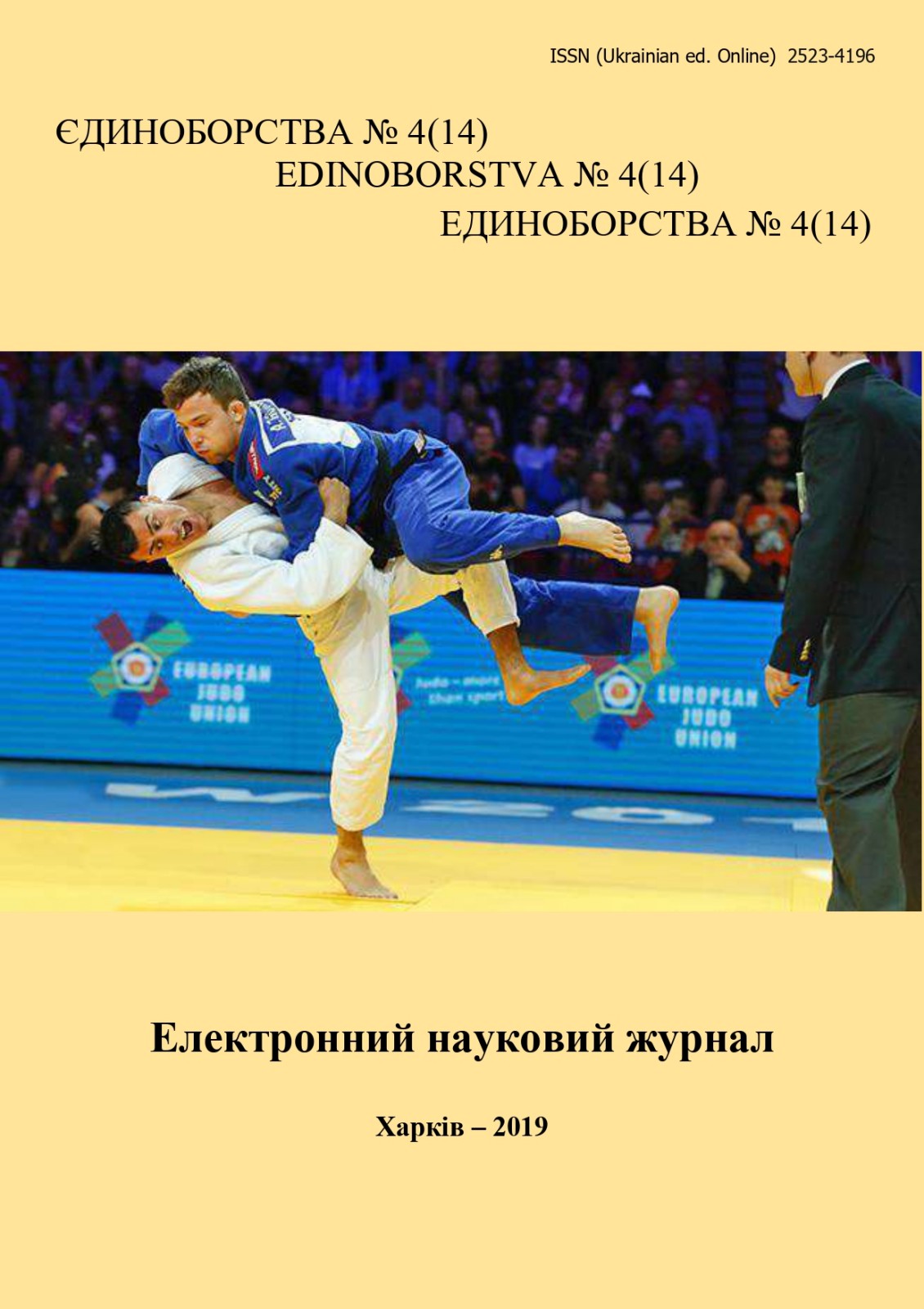Peculiarities of gender differences among athletes specializing in martial arts
DOI:
https://doi.org/10.15391/ed.2019-4.12Keywords:
gender, masculinity, femininity, androgyny, biological sex, gender differences, martial artsAbstract
Purpose: identify gender characteristics of athletes who specialize in martial arts. Material and methods: This study involved 216 students from Kharkov State Academy of Physical Culture and Sumy State Pedagogical University named after A.S. Makarenko, who are engaged in martial arts and have different sports qualifications, age 17 – 28 years. Using the S. Bam «Masculinity / Femininity» methodology for diagnosing the psychological sex and determining the degree of androgyny, masculinity and femininity of the personality and Kettell's 16-factor personality questionnaire. Results. Analyzed the ratio of men and women - participants of the Olympic competitions in sport martial arts. It is established that today the number of women participating in Olympic martial arts tournaments is less than the number of men. Among students and students who specialize in different types of martial arts, there are a greater number of martial arts athletes relative to athletes in the same percentage ratio as participants and participants in Olympic competitions, an average of 67 % of athletes: 33 % of athletes. It was revealed how martial arts classes influence the formation of the sociocultural gender of the personality of athletes and sportswomen. The percentage of masculine boys and girls and androgynous boys and girls is almost the same. Among athletes who engage in various types of martial arts, the ratio of masculine and androgynous athletes is 58 % and 42 %, respectively. In girls, we observe a similar picture. Athletes with a masculine personality type identified 56 %, and with androgynous – 44 %. If we compare the ratio of masculine athletes (58 %) and masculine athletes (56 %), we see that their number is almost the same. However, in sambo, boxing and Thai boxing and among athletes and athletes, we see that there are more masculine-type personalities than androgynous, and vice versa in hand-to-hand fighting and karate. The similarities and differences between masculine and androgynous boys and girls specializing in martial arts relative to their personality qualities were established. Conclusions. As a result of the study, it was proved that the ratio of gender personality types in men and women varies from the type of sporting activity. Analyzed the ratio of men and women - participants of the Olympic competitions in sport martial arts. It is found that the number of men almost twice the amount of a women, but there are trends towards an increase in the number of women participating in martial arts Olympic tournaments. As a result of the study, it was found that high sports qualification affects the formation of masculinity. It was found that significant differences in personal qualities, taking into account the gender type of athletes and female athletes, are observed by the factors of the communicative sphere «isolation - sociability» and «subordination - dominance», by the factor «self-confidence - anxiety», which refers to the emotional-volitional sphere and factor «conservatism - radicalism» - the intellectual sphere.
References
Артамонова Т. В. (2008). Гендерные проявления личности в спорте. ФГОУ ВПО «ВГАФК», Волгоград.
Артамонова, Т. В., & Шевченко, Т. А. (2009). Гендерная идентификация в спорте: Монография. ФГОУ ВПО «ВГАФК», Волгоград.
Бендас, Т. В. (2006). Гендерная психология.. Учебное пособие. СПб., Питер.
Ворожбитова, А. Л. (2007). «Гендерная теория физической культуры как основа формирования гендерного сознания спортсменов». Вестник Ставропольского государственного университета, № 49, 27-31.
Ильин, Е. П. (2003). Дифференциальная психология мужчины и женщины. СПб., Питер.
Ильин, Е. П. (2010). Пол и гендер. СПб., Питер..
Марченко, О. Ю. (2013). «Гендерний аспект формування цінностей фізичної культури у студентів вищих навчальних закладів». Педагогіка, психологія та медико-біологічні проблеми фізичного виховання і спорту, № 9, 50-53.
Месснер, М. (2000). «Маскулинность и профессиональный спорт». Антология гендерной теории. 118-228.
Тарасевич, Е. А. (2016). «Гендерные отличия спортсменов в различных классификационных группах видов спорта и спортивных дисциплин». Слобожанський науково-спортивний вісник, № 2 (52), 117-120.
Тарасевич Е. А., & Камаев О. И. (2018). «Гендерные различия в оценке роли занятий спортом как один из показателей качества жизни спортсменов». Фізична активність і якість життя людини. Збірник тез доповідей ІІ міжнародної науково-практичної конференції, 71.
Тарасевич, Е. А., & Надеждина, О. А. (2015). «Формирование женской олимпийской программы в спортивных единоборствах». Проблемы и перспективы развития спортивных игр и едтноборств в высших учебных заведениях, 144-149.
Цикунова, Н. Г. (2003). Гендерные характеристики личности спортсменов в маскулинных и фемининных видах спорта. (Дис. … канд. пед. наук). Питер, Россия.
Шахов, Ш. К., & Дамадаева, А. С. (2011). Спорт как фактор формирования психологического пола личности. Теория и методика спорта высших достижений, 16-18.
Bem S.L. (1983) «Gender schema theory and its implications for child development: Raising gender-schematic children in a gender-schematic society». Signs: Journal of women in culture and society, Vol. 8, № 4, 65 – 78.













